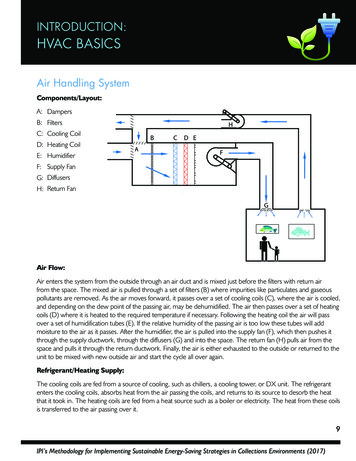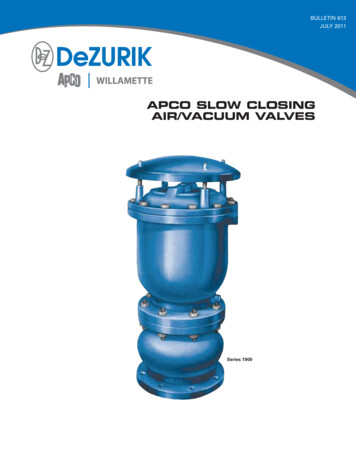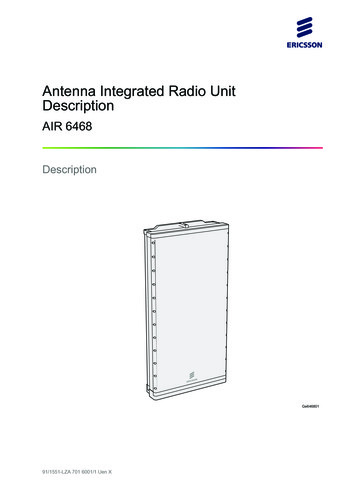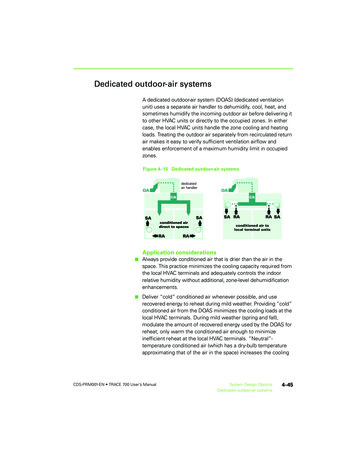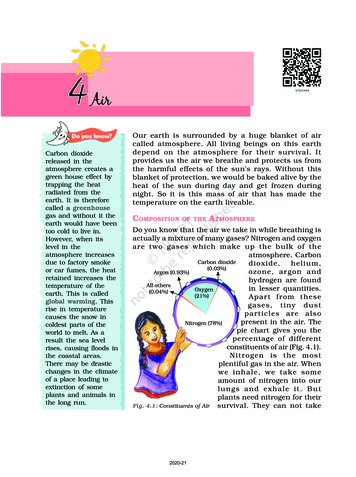
Transcription
4 AirDo you know?Carbon dioxidereleased in theatmosphere creates agreen house effect bytrapping the heatradiated from theearth. It is thereforecalled a greenhousegas and without it theearth would have beentoo cold to live in.However, when itslevel in theatmosphere increasesdue to factory smokeor car fumes, the heatretained increases thetemperature of theearth. This is calledglobal warming. Thisrise in temperaturecauses the snow incoldest parts of theworld to melt. As aresult the sea levelrises, causing floods inthe coastal areas.There may be drasticchanges in the climateof a place leading toextinction of someplants and animals inthe long run.Our earth is surrounded by a huge blanket of aircalled atmosphere. All living beings on this earthdepend on the atmosphere for their survival. Itprovides us the air we breathe and protects us fromthe harmful effects of the sun’s rays. Without thisblanket of protection, we would be baked alive by theheat of the sun during day and get frozen duringnight. So it is this mass of air that has made thetemperature on the earth liveable.COMPOSITIONOF THEA TMOSPHEREDo you know that the air we take in while breathing isactually a mixture of many gases? Nitrogen and oxygenare two gases which make up the bulk of theatmosphere. Carbondioxide,helium,ozone, argon andhydrogen are foundin lesser quantities.Apart from thesegases, tiny dustparticles are alsopresent in the air. Thepie chart gives you thepercentage of differentconstituents of air (Fig. 4.1).Nitrogen is the mostplentiful gas in the air. Whenwe inhale, we take someamount of nitrogen into ourlungs and exhale it. Butplants need nitrogen for theirFig. 4.1: Constituents of Air survival. They can not take2020-21
nitrogen directly from the air. Bacteria, that live in thesoil and roots of some plants, take nitrogen from theair and change its form so that plants can use it.Oxygen is the second most plentiful gas in the air.Humans and animals take oxygen from the air as theybreathe. Green plants produce oxygen duringphotosynthesis. In this way oxygen content in the airremains constant. If we cut trees then this balancegets disturbed.Carbon dioxide is another important gas. Greenplants use carbon dioxide to make their food andrelease oxygen. Humans or animals release carbondioxide. The amount of carbon dioxide released byhumans or animals seems to be equal to the amountused by the plants which make a perfect balance.However, the balance is upset by burning of fuels, suchas coal and oil. They add billions of tons of carbondioxide into the atmosphere each year. As a result, theincreased volume of carbon dioxide is affecting theearth’s weather and climate.ytivitcADo you know?When air is heated, itexpands, becomeslighter and goes up.Cold air is denser andheavy. That is why ittends to sink down.When hot air rises,cold air fromsurrounding arearushes there to fill inthe gap. That is howair circulation takesplace.Read and Ponder: Is global warming a serious issue in today’s world?AIR2020-2121
STRUCTUREOF THEATMOSPHEREOur atmosphere is divided into five layers starting fromthe earth’s sur face. These are T roposphere,Stratosphere, Mesosphere, Thermosphere andExosphere (Fig. 4.2).Troposphere: This layer is the most important layer ofthe atmosphere. Its average height is 13 km. The airwe breathe exists here.Almost all the weatherphenomena like rainfall,fog and hailstorm occur inthis layer.Stratosphere: Above thetroposphere lies thestratosphere. It extends upto a height of 50 km. Thislayer is almost free fromclouds and associatedweather phenomenon,making conditions mostideal for flying aeroplanes.One important feature ofstratosphere is that itcontains a layer of ozonegas. We have just learnthow it protects us fromthe harmful effect of thesun rays.Mesosphere: This is thethirdlayeroftheatmosphere. It lies abovethe stratosphere. It extendsup to the height of 80 km.Meteorites burn up inthis layer on entering fromthe space.Fig. 4.2: Layers of the Atmosphere22OUR ENVIRONMENT2020-21Thermosphere:Inthermosphere temperaturerises very rapidly withincreasingheight.Ionosphere is a part of thislayer. It extends between
80-400 km. This layer helps in radio transmission. Infact, radio waves transmitted from the earth are reflectedback to the earth by this layer.Exosphere: The upper most layer of the atmosphereis known as exosphere. This layer has very thin air.Light gases like helium and hydrogen float into thespace from here.WEATHER AND CLIMATE“Is it going to rain today?” “Will it be bright and sunnytoday?” How many times have we heard this fromanxious cricket fans speculating the fate of a One Daymatch? If we imagine our body to be a radio and themind its speaker, weather is something that fiddleswith its control knobs. Weather is this hour-to-hour,day to day condition of the atmosphere. A hot or humidweather may make one irritable. A pleasant, breezyweather may make one cheerful and even plan for anouting. Weather can change dramatically from day today. However, the average weather condition of a placefor a longer period of time represents the climate of aplace. Now do you understand why we have dailyweather forecasts.TemperatureThe temperature you feel everydayis the temperataure of theatmosphere. The degree of hotnessand coldness of the air is knownas temperature.The temperature of theatmosphere changes not onlybetween day and night but alsofrom season to season. Summersare hotter than winters.An important factor thatinfluences the distribution oftemperature is insolation.Insolation is the incoming solarenergy intercepted by the earth.The amount of insolationdecreases from the equatortowards the poles. Therefore, theLet’s doFor ten days notedown weather reportfrom a localnewspaper andobserve the changesoccurring in theweather.Do you know?You will be surprisedto know that theearth receives only 1in 2,000,000,000parts of the sun’senergy.Thermometer:Measuresthe temperatureBarometre: Measuresatmospheric pressureRain Gauge: Measuresthe amount of rainfallWind Vane: Shows thedirection of the windFig. 4.3: Weather InstrumentsAIR 232020-21
Do you know?The standard unit ofmeasuringtemperature is degreeCelsius. It wasinvented by AndersCelsius. On theCelsius scale thewater freezes at 0 Cand boils at 100 C.Do you know?On the moon there isno air and hence noair pressure.Astronauts have towear specialprotective space suitsfilled with air whenthey go to the moon. Ifthey did not wearthese space suits, thecounter pressureexerted by the body ofthe astronauts wouldmake the blood vesselsburst. The astronautswould bleed.Do you know?A wind is named afterthe direction fromwhich it blows, e.g.the wind blowing fromthe west is calledwesterly.24temperature decreases in the same manner. Now doyou understand why poles are covered with snow? Ifthe earth’s temperature rises too high, it would becometoo warm for some crops to grow. Temperature in citiesis much higher than that of villages. The concrete andmetals in buildings and the asaphalt of roads getheated up during the day. This heat is released duringthe night.Also, the crowded high rise buildings of the citiestrap the warm air and thus raise the temperature ofthe cities.Air PressureYou will be surprised to know that air above us pressesus with a great force on our bodies. However, we don’teven feel it. This is because the air presses us from alldirections and our body exerts a counter pressure.Air pressure is defined as the pressure exerted by theweight of air on the earth’s surface. As we go up thelayers of atmosphere, the pressure falls rapidly. The airpressure is highest at sea level and decreases with height.Horizontally the distribution of air pressure is influencedby temperature of air at a given place. In areas wheretemperature is high the air gets heated and rises. Thiscreates a low-pressure area. Low pressure is associatedwith cloudy skies and wet weather.In areas having lower temperature, the air is cold. Itis therefore heavy. Heavy air sinks and creates a highpressure area. High pressure is associated with clear andsunny skies.The air always moves from high pressure areas to lowpressure areas.WindThe movement of air from high pressure area to lowpressure areas is called wind. You can see wind at workas it blows dry leaves down the pavement or uprootstrees during a storm. Sometimes when the wind blowsgently you can even see it blowing away smoke or finedust. At times wind can be so strong that it is difficultto walk against it. You must have experienced it is noteasy to hold an umbrella on a windy day. Think ofsome other examples when strong winds have createdOUR ENVIRONMENT2020-21
90 Nproblems for you. Winds can bebroadly divided into three types.High PressurePolarEasterlies1.Permanent winds – The trade60 NSub-Polar Low Pressurewinds, westerlies and easterliesare the permanent winds.P r e v a i l i n g We s t e r l i e sThese blow constantly35 NSub - Tropical High Pressure (Horse Latitudes)30 Nthroughout the year in a23.5 N T r o p i c o f C a n c e rparticular direction.Northeast Trade Winds2.Seasonal winds – Thesewinds change their directionin different seasons. Forexample monsoons in India.3.Equatorial Low0 Pressure (Doldrums)Southeast Trade Winds23.5 S30 ST rop i c of C apri co r nSub - Tropical High Pressure (Horse Latitudes)35 SLocal winds – These blowonly during a particularperiod of the day or year in asmall area. For example, landand sea breeze. Do you recall thehot and dry local wind of northernplanes of India? It is called loo.Prevailing60 SWe s t e r l i e sSub-Polar Low PressurePolarEasterliesHigh Pressure90 SFig. 4.4: Major Pressure Belts and Wind SystemCYCLONE – NATURE’S FURYOdisha, located on the easternseacoast of India is prone tocyclones that originate in theBay of Bengal. On 17-18October 1999, cyclone hit fivedistricts of the state. Anothersupercyclone occurred on the29 October 1999, thatdevastated large portions of thestate. The damages causedwere mainly due to threefactors: wind velocity, rain andDestruction caused by a cyclonetidal surge. The winds of upto260 km. per hour lasted for over 36 hours. These high velocity windsuprooted trees and damaged the kutcha houses. Roof tops of severalindustrial sheds and other houses were also blown away. Power supplyand telecom lines snapped completely. Heavy rain occurred under theinfluence of the cyclone for three days continuously. These rains led toflooding in the major rivers of Odisha. The cyclonic winds caused tidalwaves that swept 20 km. inland and brought massive destruction to thecoastal areas. The 7 to 10 m high tidal wave intruded suddenly andcaused massive damage to the standing paddy crops.AIR 252020-21
The cyclone originated as a “depression” in the Gulf of Thailand,near east of Port Blair, on 25 October 1999 and gradually moved in anorthwestward direction. It intensified into a supercyclone and hit the areabetween Erasama and Balikuda in Odisha on 29 October at 10.30 a.m.The supercyclone swept the entire coast of Odisha including thecities of Bhubaneshwar and Cuttack and 28 coastal towns. About 13million people were affected. A large number of livestock were killed.Standing crops of paddy, vegetables and fruits were heavily damaged.Due to salinisation caused by tidal surge, large tracts of agriculturalland have turned infertile. Large tracts of sal, teak and bambooplantations have disappeared. The mangrove forests between Paradeepand Konark vanished.ColdairWarmairCyclonic RainfallMoistairRelief (Orographic) RainfallWarmairConvectional RainfallFig. 4.5: Types of Rainfall26MoistureWhen water evaporates from land and differentwater bodies, it becomes water vapour. Moisturein the air at any time, is known as humidity.When the air is full of water vapour we call it ahumid day. As the air gets warmer, its capacityto hold the water vapour increases and so itbecomes more and more humid. On a humidday, clothes take longer to dry and sweat fromour body does not evaporate easily, making usfeel very uncomfortable.When the water vapour rises, it starts cooling.The water vapour condenses causing formationof droplets of water. Clouds are just masses ofsuch water droplets. When these droplets of waterbecome too heavy to float in air, then they comedown as precipitation.Jet planes flying in the sky leave a white trailbehind them. The moisture from their enginescondenses. We see trails of this condensedmoisture for some time when there is no airmovement to disturb it.Precipitation that comes down to the earthin liquid form is called rain. Most of the groundwater comes from rainwater. Plants help preservewater. When trees on hill sides are cut, rainwaterflows down the bare mountains and can causeflooding of low lying areas. On the basis ofmechanism, there are three types of rainfall: theconvectional rainfall, the orographic rainfall andthe cyclonic rainfall (Fig. 4.5).OUR ENVIRONMENT2020-21
Rainfall is very important for the survival of plants andanimals. It brings fresh water to the earth’s surface. Ifrainfall is less – water scacity and drought occur. On theother hand if it is more, floods take place.Do you know?Other forms ofprecipitation aresnow, sleet, hail.Exercises1. Answer the following questions.(i) What is atmosphere?(ii) Which two gases make the bulk of the atmosphere?(iii) Which gas creates green house effect in the atmosphere?(iv) What is weather?(v) Name three types of rainfall?(vi) What is air pressure?2. Tick the correct answer.(i) Which of the following gases protects us from harmful sun vays?(a) Carbon dioxide (b) Nitrogen(c) Ozone(ii) The most important layer of the atmosphere is(a) Troposphere(b) Thermosphere (c) Mesosphere(iii) Which of the following layers of the atmosphere is free from clouds?(a) Troposphere(b) Stratosphere(c) Mesosphere(iv) As we go up the layers of the atmosphere, the pressure(a) Increases(b) Decreases(c) Remains the same(v) When precipitation comes down to the earth in the liquid form,it is called(a) Cloud(b) Rain(c) Snow3. Match the following.(i) Trade Winds(a) Incoming solar energy(ii) Loo(iii) Monsoon(b) Seasonal wind(c) Horizontal movement of Air(iv) Wind(d) Layer of ozone gas(e) Permanent wind(f) Local wind4. Give reasons.(i) Wet clothes take longer time to dry on a humid day?(ii) Amount of insolation decreases from equator towards poles?AIR 272020-21
5. For fun.(i) Solve this Crossword puzzle with the help of given clues:AcrossDown6. An Indian tree having extraordinaryquality of providing oxygen round theclock8. Gas present in atmosphere occupyingonly 0.03% by volume11. Outermost layer of atmosphere12. Mixture of many gases3. Example of local wind blowing in summerin northern india4. Short term changes in atmosphere5. Precipitation in liquid form7. Blanket of air around the earth14. Life giving gas15. Air in motion16. An indian tree valued highly formedicinal properties18. Gas protecting us from harmful sunrays19. Low pressure area281. Amount of water vapour in air2. Condensation of water vapours arounddust particles in atmosphereOUR ENVIRONMENT2020-219. Instrument to measure pressure10. Incoming solar radiation13. Reduces visibility in winters17. It is . time when sun is overhead
(ii) Make a weather calendar for one week. Use pictures or symbols to showdifferent types of weather. You can use more than one symbol in a day, ifthe weather changes. For example, the sun comes out when rain stops. Anexample is given below:Day1.WeatherSunny day2.3.4.5.6.7.AIR 292020-21
When air is heated, it expands, becomes lighter and goes up. Cold air is denser and heavy. That is why it tends to sink down. When hot air rises, cold air from surrounding area rushes there to fill in the gap. That is how air





